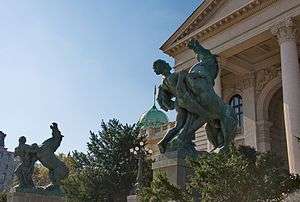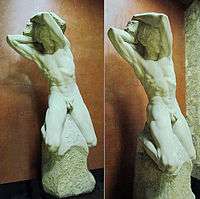Toma Rosandić
Toma Rosandić (Serbian Cyrillic: Тома Росандић; baptized as Tomaso Vincenzo, 22 January 1878 - 1 March 1958) was a Serbian sculptor, architect and fine arts pedagog. Together with Ivan Meštrović (1883-1962), he was the most prominent of the Serbian and Yugoslavian sculptors of his day.

Rosandić was born in Split, Habsburg Croatia, on the Dalmatian coast, the son of a stoneworker. His family name, Rosandić originates from Podgora a small coastal village in Southern Dalmatia about 70 km south of Split. During the early years in Split, Rosandić learnt to carve in wood as well as stone and was much inspired by the younger Meštrović who had moved there from Otavice. Both sculptors studied overseas before returning to Split, Rosandić touring Italy and exhibiting in Milan in 1906 and Belgrade in 1912.
Something of their parallel development and underlying rivalry can be understood from their respective projects to combine sculpture and architecture. Both constructed a mausoleum, Rosandić for the Petrinović family (Supetar, on the island of Brač off Split) and Meštrović to the Račić family (Cavtat, south of Dubrovnik). Each exhibit the influence of Dalmatian history, but while Meštrović's mausoleum is based on the principle of simplicity, Rosandić richly ornamented his building with a blend of Gothic and Renaissance motifs to express a more national character.

With the outbreak of World War I, Rosandić left for London where he exhibited at the Grafton Galleries in 1917 and later in Brighton and Edinburgh. During World War II, Rosandić settled in Belgrade. He was interned by the German occupation forces during the war, but was later released through the intervention of Dragomir Jovanović. Rosandić later testified at the Belgrade Process.
Rosandić was a member of the Serbian Academy of Sciences and Arts since 1948. He founded a prominent school in Belgrade known as the "Master Workshop". Amongst the many artists and public personalities that frequented the workshop was Henry Moore, during his exhibition in Belgrade in March 1955.
In his maturity, Rosandić executed two of his greatest masterpieces: the pair of stone statues of a man struggling with a horse, which flank the entrance to the Federal Parliament building in Belgrade (today Parliament of Serbia), and a massive stone frieze of figures for a monument in Subotica, Vojvodina, Serbia (1952). Many of his bronze projects at this time were cast in the Voždovac foundry and other works by his hand can be found at the Toma Rosandić Memorial Museum and the Museum of Contemporary Art, Belgrade.
He returned to his beloved Split before his death in 1958.